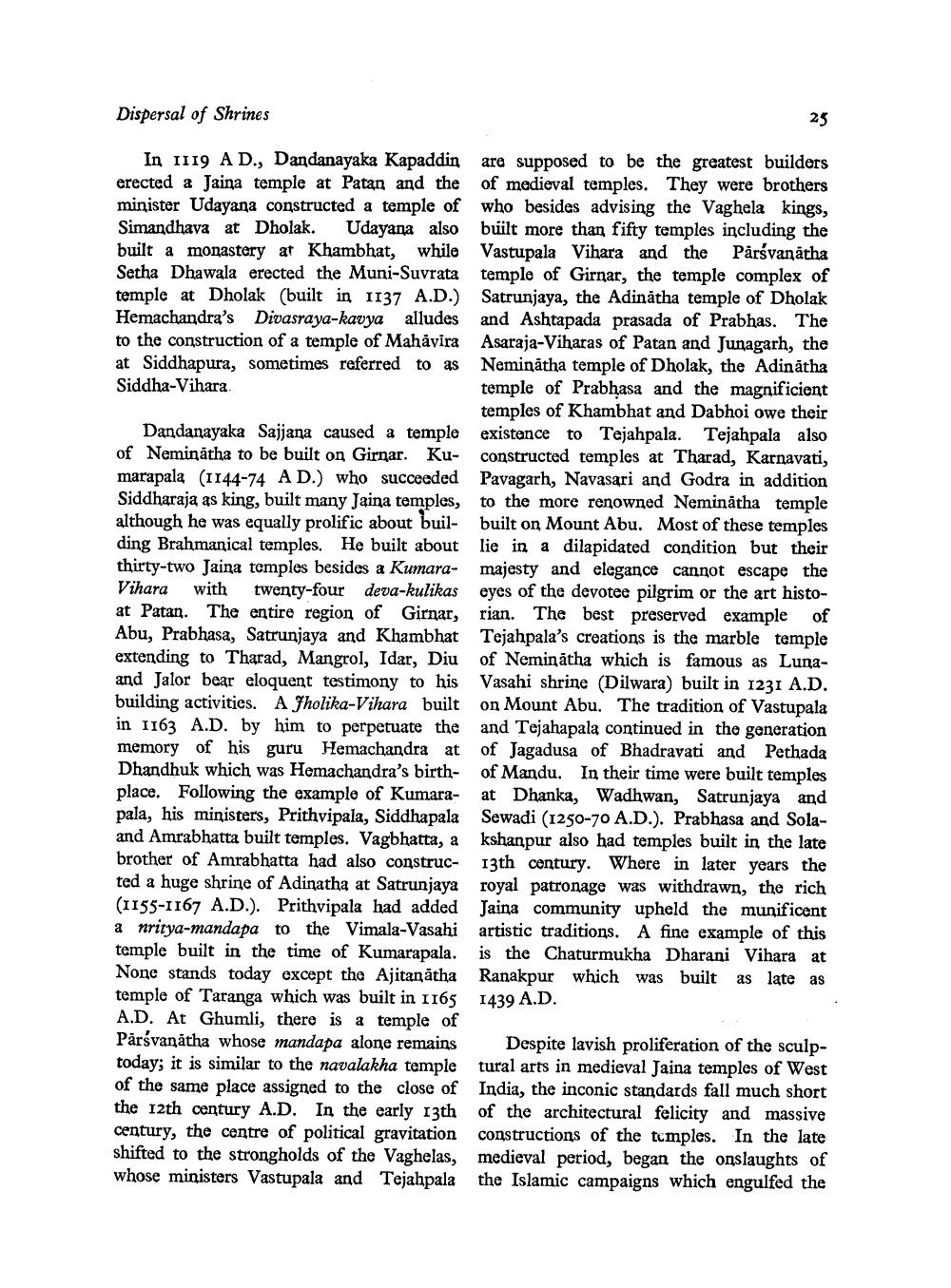________________
Dispersal of Shrines
In 1919 A D., Dandanayaka Kapaddin are supposed to be the greatest builders erected a Jaina temple at Patan and the of medieval temples. They were brothers minister Udayana constructed a temple of who besides advising the Vaghela kings, Simandhava at Dholak. Udayana also built more than fifty temples including the built a monastery at Khambhat, while Vastupala Vihara and the Pårsvanatha Setha Dhawala erected the Muni-Suvrata temple of Girnar, the temple complex of temple at Dholak (built in 1137 A.D.) Satrunjaya, the Adinātha temple of Dholak Hemachandra's Divasraya-kavya alludes and Ashtapada prasada of Prabhas. The to the construction of a temple of Mahavira Asaraja-Viharas of Patan and Junagarh, the at Siddhapura, sometimes referred to as Neminátha temple of Dholak, the Adinatha Siddha-Vihara
temple of Prabhasa and the magnificient
temples of Khambhat and Dabhoi owe their Dandanayaka Sajjana caused a temple existence to Tejahpala. Tejahpala also of Neminátha to be built on Girnar. Ku- constructed temples at Tharad, Karnavati, marapala (1144-74 A D.) who succeeded Pavagarh, Navasari and Godra in addition Siddharaja as king, built many Jaina temples, to the more renowned Neminātha temple although he was equally prolific about buil- built on Mount Abu. Most of these temples ding Brahmanical temples. He built about lie in a dilapidated condition but their thirty-two Jaina temples besides a Kumara- majesty and elegance cannot escape the Vihara with twenty-four deva-kulikas eyes of the devotee pilgrim or the art histoat Patan. The entire region of Girnar, rian. The best preserved example of Abu, Prabhasa, Satrunjaya and Khambhat Tejahpala's creations is the marble temple extending to Tharad, Mangrol, Idar, Diu of Neminātha which is famous as Lunaand Jalor bear eloquent testimony to his Vasahi shrine (Dilwara) built in 1231 A.D. building activities. Afholika-Vihara built on Mount Abu. The tradition of Vastupala in 1163 A.D. by him to perpetuate the and Tejahapala continued in the generation memory of his guru Hemachandra at of Jagadusa of Bhadravati and Pethada Dhandhuk which was Hemachandra's birth- of Mandu. In their time were built temples place. Following the example of Kumara- at Dhanka, Wadhwan, Satrunjaya and pala, his ministers, Prithvipala, Siddhapala Sewadi (1250-70 A.D.). Prabhasa and Solaand Amrabhatta built temples. Vagbhatta, a kshanpur also had temples built in the late brother of Amrabhatta had also construc- 13th century. Where in later years the ted a huge shrine of Adinatha at Satrunjaya royal patronage was withdrawn, the rich (1155-1167 A.D.). Prithvipala had added Jaina community upheld the munificent a nritya-mandapa to the Vimala-Vasahi artistic traditions. A fine example of this temple built in the time of Kumarapala. is the Chaturmukha Dharani Vihara at None stands today except the Ajitanātha Ranakpur which was built as late as temple of Taranga which was built in 1165 1439 A.D. A.D. At Ghumli, there is a temple of Pärsvanatha whose mandapa alone remains Despite lavish proliferation of the sculptoday; it is similar to the navalakha temple tural arts in medieval Jaina temples of West of the same place assigned to the close of India, the inconic standards fall much short the 12th century A.D. In the early 13th of the architectural felicity and massive century, the centre of political gravitation constructions of the temples. In the late shifted to the strongholds of the Vaghelas, medieval period, began the onslaughts of whose ministers Vastupala and Tejahpala the Islamic campaigns which engulfed the




